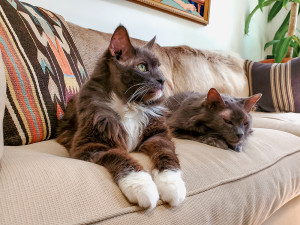How to Introduce a Kitten to an Older Cat
Nice to meet you!

Share Article
In This Article:
Cat Introduction Timeline How to Get an Older Cat to Like a Kitten Steps: Introducing a Kitten to a Cat Frequently Asked Questions
Introducing cats can be a challenge. There’s an instinctual reaction to seeing a stranger cat that can cause stress, fear, concern over resources, and even defensive aggression. This is why a slow, careful introduction is so important, even when you’re introducing a sweet, innocent kitten to your older cat.
Working with your cat’s needs and instincts instead of pushing against them will set you up for success. Let’s talk kitty intros.
Cat introduction timeline and expectations
On one hand, introducing a kitten to an older cat can be easier than introducing two older cats. It also comes with its own set of challenges. Some older cats find kittens less threatening. They may be more curious and less defensive toward a kitten, though the kitten may find that curiosity intimidating.

Other cats don’t care about age. Kittens grow up and can start fights and steal resources. So, the older cat may be defensive and nervous regardless of the kitten’s age. The introduction process is what helps you navigate these reactions.
I know your big question: How long will it take to introduce my cat to my new kitten? The truth is there’s no set-in-stone timeline. I suggest letting the cats guide the timing. If they don’t have a big reaction to each other, that’s great! Going through a careful intro process is still good, but you’ll move through it more quickly.
If there’s some tension or fear, or your older cat is so excited that they could injure the kitten, you’ll take more time to move through the steps. Plan on months, not weeks. If it happens faster, it’s a pleasant surprise. If it takes longer, you’ll expect it and won’t be disappointed.
Considerations for introducing an older cat and a kitten
Before you start your introduction, it’s helpful to be aware of some things that can impact your progress.
Different energy levels
One of the primary reasons older and younger cats have relationship issues is a difference in energy levels. Kittens hit their peak energy and play aggression window between about nine months and two years old. At this age, they’re programmed to get good at two vital “cat” things — hunting and defense. And anything that moves can be practice.
Two kittens will spend hours a day wrestling, stalking each other, etc. Your older cat will take the brunt of that (it’s called play aggression), especially if there’s no other outlet for your kitten. That means your older cat may become defensive, aggressive, fearful, and even start hiding in response to your kitten’s high-energy and play-aggressive behavior.
The best things you can do to manage this are multiple daily play sessions that replicate hunting and lots of mental and physical enrichment, like self-play toys, food puzzles, training sessions, etc.
Preparing your older cat
Kittens are pretty resilient and fearless. Older cats are more prone to stress and reactivity. It’s important to help your older cat reduce stress and feel secure. Daily interactive play sessions, mental enrichment, and bonding time with you will help.
One of the most important aspects of this whole process is not pushing either cat past their comfort zone. You’ll want to watch for even tiny signs of stress, fear, nervousness, etc. If you see it, turn the intensity down. Don’t push — especially your older cat.
Preparing the environment
One aspect of helping your older cat and kitten feel secure is setting up their environment properly.
Until they’re getting along well, they should be separated, coming together only for supervised time. Each should have a “safe space” with everything they need. When separated, you can rotate them into the main living area so they get time with you.
Provide multiples of key resources. These include food, water, litter boxes, high perches, hiding spots, resting spots, and scratchers. Spread them out. Avoid clumping all the litter boxes, for example, in one room. They should have easy access to resources wherever they are in the home. This will increase their comfort moving around, especially if your older cat sees your kitten as a tiny predator.
Uncovered litter boxes are your best bet. Your older cat will feel safer using the box if they have open sight lines and can see that your kitten isn’t sitting outside the box, ready to pounce on them.
Introducing the cats
It’s time to introduce these two. In my experience, it’s best to do a slow, careful intro regardless of the situation. However, some older cats do quite well with kittens without too much work. So, you could do a little test to see how they respond to each other first. If it goes well, you can continue down that path. If not, the slow intro will be best.
Do an intro test
When you bring your kitten home, have your older cat in another room so they don’t see each other. Get your kitten into their safe space. That’s where they should stay for at least a few days unless you’re right there to supervise them. They need to adjust to the new home slowly and safely.
During this time, rub your kitten with a clean sock. Take that sock to your older cat. Set it on the floor nearby with treats on top. This is how you positively introduce your kitten’s scent to your older cat. Do this at least once a day for a couple of days.
If your older cat eats the treats and doesn’t react to the sock, try letting them see each other. Do this with a barrier (like two stacked baby gates) and lots of space between them. Have something positive for them to focus on, like treats. Let them check each other out from a distance.
If that goes well, move them closer together over a few days. If all is going really well and no one seems at all nervous, start closely supervised sessions where they share space. Make these very short to start and gradually increase the length as they’re ready.
Fostering the relationship between the cats
When the cats see each other through the barrier or share space, make good things happen. Show them that being calm around each other means treats, pets, mellow play, verbal praise, etc.
Need a slower introduction?
If either cat has any nervousness, fear, or aggression during the test intro, the best thing is to go through a slower, more careful intro process. I promise it’s worth the effort. You can’t power through. Once a cat has their defenses up, they stay up. Go with a less intense introduction. Don’t worry! We’ve got an article that gives you tons of information. Contact a certified feline training and behavior consultant for more support.
Signs your cat is accepting the new kitten
First, let’s start with signs your cat is not feeling good about what’s happening. If you see these from either cat, turn the intensity down:
Dilated pupils (saucer eyes)
Unwilling to turn their back or look away from each other
Hissing or vocalizing
Trying to look larger or smaller
Puffed fur (piloerection)
Licking the lips
Fidgeting
Tail twitching in an agitated way
Skin twitching
General nervous behavior
If they’re feeling relaxed around each other, their guard isn’t up, and they’re not fearful, you may see:
Soft face and posture
Fine turning away from each other; not fixated
Easily distracted
Sitting or lying down vs. staying up and on alert
Slowly and calmly leaving the area vs. running or hiding
And, of course, any positive interactions they have with each other are a good sign.
FAQs (People also ask)
When can my kitten meet other cats?
Letting your kitten decompress and get comfortable in their new home before they meet other cats is a good idea. This transition can be a big one for some cats. There’s no rush. The more secure and relaxed they feel, the better the meeting will go.
When can my cat meet my dog?
When cats and dogs should meet depends on many factors, including the dog’s comfort with cats and how well their prey drive is managed. It’s best to let your cat get very comfortable in their new home before the introduction. The more secure your cat feels in the space, the less reactive they may be to the dog.
Is my cat lonely?
Cats can certainly feel lonely. This is especially true for kittens who left litter mates and are now solo. Vocalizing, not wanting to be away from you, nervousness, destructive behaviors, and more can be clues that your cat needs mental and physical enrichment and bonding time with you.
How to introduce a new cat to your family?
How and when to let family and friends meet your new cat depends on the cat’s temperament and comfort in their new home. If you have a friendly, fearless, ready-to-explore cat, they may be ready to meet people right away.
A nervous cat who’s maybe hiding, taking some time adjusting to their new space, and feeling anxious may need time to settle in. Meeting people in short sessions, one at a time, can also help.
References

LeeAnna Buis, CFTBS, FFCP
LeeAnna Buis has adored cats her entire life and thought she knew them inside out and sideways. But it wasn’t until she worked with a feline behavior consultant that she fully understood how incredible, complicated, and inspiring they really are. She made a career change, starting the certification process to become a behavior consultant right away. She discovered what unique, fascinating, complex creatures cats are and knew this was what she wanted to do with her life — help others on a similar journey to truly knowing, loving, and appreciating their cats.
LeeAnna earned her certification through Animal Behavior Institute, where she received the certified feline training and behavior specialist (CFTBS) designation.
Related articles
![cat hissing under chair]()
Cat Hissing: Fair Warning or Fighting Words?
Your cat’s hissy fit could mean Don’t test me or Let’s do this. We wouldn’t call their bluff.
![Two senior cats laying on a couch]()
Why Senior Cats Make the Best Roommates
Kitten, please! I adopted a couple of seniors because cats, like wine, only get better with age.
![Two tabby cats cuddling each other with their eyes closed]()
Cats Aren’t Loners, After All
Cat behaviorist Kristiina Wilson on the importance of socializing cats.
![Cat hissing at a person attempting to pet its cheek]()
Does Your Cat Hate Your New Partner?
How to help your kitty warm up to your S.O.
![Curly afro woman stroking her bonded cats on the couch in living room]()
Should I Adopt a Bonded Pair?
Some besties are inseparable, and that’s not always a bad thing.
How Long Can Cats Be Left Alone?
Believe it or not, they miss you when you’re gone.










